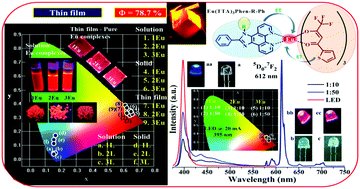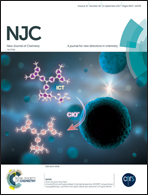Effects of electron-withdrawing groups in imidazole-phenanthroline ligands and their influence on the photophysical properties of EuIII complexes for white light-emitting diodes†
Abstract
Herein, three europium complexes (Eu(TTA)3Phen-Ph-Ph, Eu(TTA)3Phen-mCF3-Ph, and Eu(TTA)3Phen-pCF3-Ph) were designed and synthesized. The N1-functionalization of the phenanthro-imidazole ring by phenyl and substituted phenyl moieties (CF3, an electron-withdrawing group) and their influences on the photophysical and electrochemical properties of EuIII complexes were determined through experimental and theoretical analyses. All the complexes in the solid state and in solution showed the distinctive emission of EuIII ion at 612 nm due to the electric dipole transition (5D0 → 7F2). Absence of ligand emission (400–600 nm; solution, thin film, and solid states) in the PL emission spectra of EuIII complexes clearly indicates efficient energy transfer from the ligand to the central metal ion (antenna effect). This was confirmed by the values of the singlet and triplet energy levels of the ligands calculated via density functional theory and time-dependent density functional theory (DFT, TD-DFT) analyses. The HOMO–LUMO levels of the complexes were determined through cyclic voltammetric studies. In addition, the Eu-complex was doped in poly(methyl methacrylate) (PMMA) to fabricate composite film devices; Eu(TTA)3Phen-pCF3-Ph complex showed highest quantum yield (78.7%). Red emission from the fabricated LEDs (EuIII complexes coated on InGaN-based LED (395 nm)) was obtained with the CIE values of x = 0.65, y = 0.34.



 Please wait while we load your content...
Please wait while we load your content...